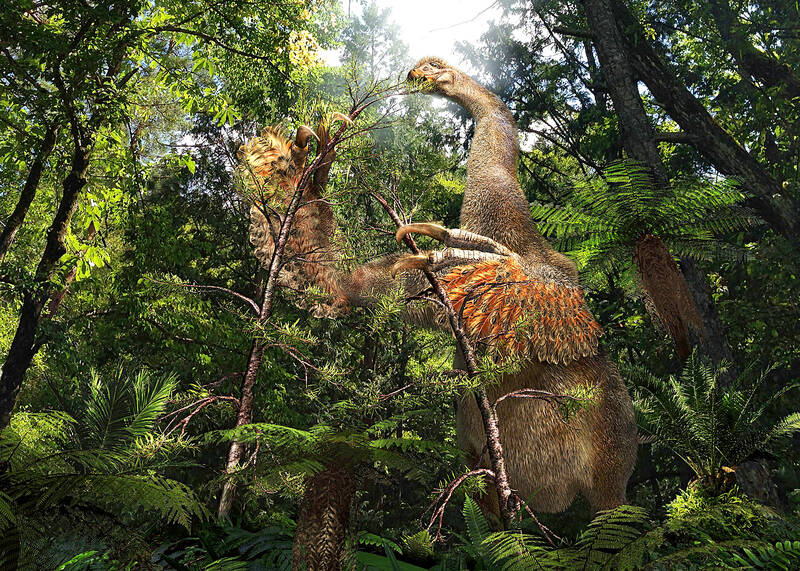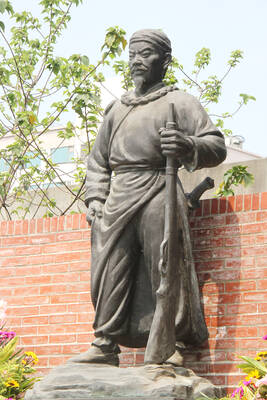Fossils unearthed during construction of a water pipeline in the Gobi Desert of Mongolia have revealed one of the oddest members of a rather strange group of dinosaurs, a creature whose two-fingered hands sport a pair of menacing curved claws. The dinosaur, named Duonychus tsogtbaatari, measured about 3 meters long, weighed approximately 260 kg and lived roughly 90 to 95 million years ago during the Cretaceous Period, researchers said. Its claws measured about 30 cm long.
Duonychus was a medium-sized member of a group of awkward-looking dinosaurs called therizinosaurs, which were known for having a rotund torso, long neck, small head, bipedal stance, feathers on the body and massive claws on the hands. While they were part of the dinosaur clade called theropods that included all the meat-eaters such as Tyrannosaurus and Spinosaurus, therizinosaurs preferred plants on their menu.
Therizinosaurs, which inhabited Asia and North America, are distinguished by their large claws. Until now, every known therizinosaur had three clawed fingers. But Duonychus possessed one fewer, making it fitting that its name means “two claw.”

Photo: Reuters
“Therizinosaurs are some of the weirdest dinosaurs ever. They were theropods — so, related to meat-eaters — but they looked like giant feathered sloths,” said paleontologist Yoshitsugu Kobayashi of Hokkaido University Museum in Japan, lead author of the research published on Tuesday in the journal iScience.
“Duonychus takes that weirdness even further. It had this short, two-fingered hand with claws like a raptor (swift meat-eating dinosaurs), but it used them to eat plants. It’s like evolution said, ‘Let’s try something totally new.’ And it worked,” Kobayashi said.
The researchers said this Duonychus individual was not fully grown. It roamed a semi-arid environment with river channels alongside other therizinosaurs, armored dinosaurs, horned dinosaurs, duck-billed dinosaurs and a smaller forerunner of Tyrannosaurus called Alectrosaurus.

Photo: Reuters
While the skeleton recovered was incomplete — for instance, missing its skull and legs — the arms and hands were well-preserved.
One of the claws retained its outer covering — a sheath of keratin, the same material as in our fingernails — rather than just the underlying bone. The keratin sheath added more than 40 percent to the claw’s length.
“These were big, sharp and nasty claws,” said paleontologist and study co-author Darla Zelenitsky of the University of Calgary in Canada.
“That’s incredibly rare,” Kobayashi said of the keratin fossilization, “and it gives us an extraordinary window into how these dinosaurs actually used their hands in life. The hands are beautifully preserved and show a ton of detail, including fused wrist bones, stiff joints and the two massive claws.”
The claws may have served multiple functions, though primarily used for grabbing and pulling down branches to feed on leaves.
“They could have used the claws for other purposes as well, perhaps for grappling, defense, digging and maybe even recognizing one’s own species — ‘Hey, look at me. I also have only two fingers,’” Zelenitsky said.
Duonychus is an example of digit reduction — losing fingers or toes through evolution. The first land vertebrates had eight digits. The earliest dinosaurs had hands with five fingers, just as people do, but many dinosaur lineages experienced digit reduction over time.
The discovery of Duonychus means there are now no fewer than five lineages of theropods known to have independently evolved just two fingers on each hand. The most famous of these was T. rex, a member of the group called tyrannosaurs whose puny arms were way out of proportion with its enormous head and torso.
So why would fewer fingers be beneficial?
“With dinosaurs that grasped vegetation during foraging, one would think more fingers would be better. That was obviously not the case with Duonychus, as its hand construction with two fingers seemed to suit it just fine. I suspect it may have had a specialized feeding behavior or food source,” Zelenitsky said.
“Tyrannosaurs were hypercarnivorous beasts with massive skulls and jaws designed for seizing and killing prey,” Zelenitsky added. “For them, the fingers and arms were probably reduced because they were pretty useless compared to their skull.”

One of the biggest sore spots in Taiwan’s historical friendship with the US came in 1979 when US president Jimmy Carter broke off formal diplomatic relations with Taiwan’s Republic of China (ROC) government so that the US could establish relations with the People’s Republic of China (PRC). Taiwan’s derecognition came purely at China’s insistence, and the US took the deal. Retired American diplomat John Tkacik, who for almost decade surrounding that schism, from 1974 to 1982, worked in embassies in Taipei and Beijing and at the Taiwan Desk in Washington DC, recently argued in the Taipei Times that “President Carter’s derecognition

JUNE 30 to JULY 6 After being routed by the Japanese in the bloody battle of Baguashan (八卦山), Hsu Hsiang (徐驤) and a handful of surviving Hakka fighters sped toward Tainan. There, he would meet with Liu Yung-fu (劉永福), leader of the Black Flag Army who had assumed control of the resisting Republic of Formosa after its president and vice-president fled to China. Hsu, who had been fighting non-stop for over two months from Taoyuan to Changhua, was reportedly injured and exhausted. As the story goes, Liu advised that Hsu take shelter in China to recover and regroup, but Hsu steadfastly

This year will go down in the history books. Taiwan faces enormous turmoil and uncertainty in the coming months. Which political parties are in a good position to handle big changes? All of the main parties are beset with challenges. Taking stock, this column examined the Taiwan People’s Party (TPP) (“Huang Kuo-chang’s choking the life out of the TPP,” May 28, page 12), the Democratic Progressive Party (DPP) (“Challenges amid choppy waters for the DPP,” June 14, page 12) and the Chinese Nationalist Party (KMT) (“KMT struggles to seize opportunities as ‘interesting times’ loom,” June 20, page 11). Times like these can

You can tell a lot about a generation from the contents of their cool box: nowadays the barbecue ice bucket is likely to be filled with hard seltzers, non-alcoholic beers and fluorescent BuzzBallz — a particular favorite among Gen Z. Two decades ago, it was WKD, Bacardi Breezers and the odd Smirnoff Ice bobbing in a puddle of melted ice. And while nostalgia may have brought back some alcopops, the new wave of ready-to-drink (RTD) options look and taste noticeably different. It is not just the drinks that have changed, but drinking habits too, driven in part by more health-conscious consumers and